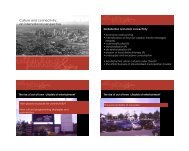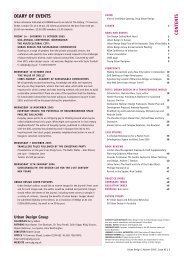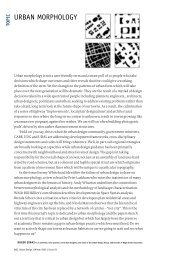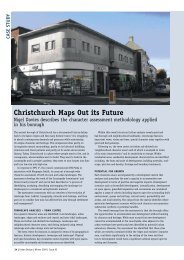CONTENTS DIARY OF EVENTS - The Urban Design Group
CONTENTS DIARY OF EVENTS - The Urban Design Group
CONTENTS DIARY OF EVENTS - The Urban Design Group
Create successful ePaper yourself
Turn your PDF publications into a flip-book with our unique Google optimized e-Paper software.
FRONT TO BACK – A DESIGN AGENDA FOR URBAN HOUSING<br />
SALLY LEWIS, ELSEVIER, 2005, £24.99<br />
ISBN 0 7506 5179 2<br />
DESIGNING AMERICA’S WASTE LANDSCAPE<br />
MIRA ENGLER, THE JOHNS HOPKINS UNIVERSITY PRESS, 2004, £33.50<br />
ISBN 0 801 87803 9<br />
We would much rather take the garbage<br />
out than think about where its going.<br />
Yet it is a key element in the way we<br />
shape our landscape, and we have<br />
overwhelming negative perceptions of<br />
the places where we tip. <strong>The</strong> subject is<br />
marginalised within the public debate,<br />
which limits our ability to respond<br />
creatively to the growing problem of<br />
waste disposal.<br />
This is an important book at a time when<br />
higher densities are being encouraged<br />
and housing programmes are critical to<br />
proposals for expansion in the south<br />
east. It is a design guide arranged<br />
in two parts, the first describing the<br />
background to housing issues and the<br />
second outlining the design agenda and<br />
providing a detailed analysis of five case<br />
studies.<br />
It is not laid out like a normal book<br />
but as a design primer with consistent<br />
headings of key points and in that<br />
respect will be an invaluable guide to<br />
students involved in this type of project.<br />
<strong>The</strong> first part contains four chapters<br />
covering urban design, sustainability,<br />
community and social agendas<br />
addressing the key principles that should<br />
be followed, although the social chapter<br />
is perhaps less specific than it might<br />
have been.<br />
<strong>The</strong> second part includes an<br />
excellent summary of a design agenda<br />
This book is one of a series on<br />
contemporary American landscape<br />
design, providing a workman-like<br />
account of the issues. <strong>The</strong> author is<br />
a landscape architect with concerns<br />
about waste management which were<br />
aroused by a desire to reuse wasted<br />
neighbourhood open spaces, such<br />
as back alleys and small parks. She<br />
finds the subject seemingly hideous<br />
and prosiac, but she sets free their<br />
contradictory powers, and immersed<br />
herself in research about waste<br />
landscapes and societal issues.<br />
<strong>The</strong> five chapters start with theories<br />
and constructs, definitions, and the<br />
language of waste - valued and valueless,<br />
smell, taboos, marginalia and cultural<br />
discourse. She sets out a detailed history<br />
with eight distinct periods of residential<br />
landscapes each lasting 30-50 years,<br />
starting in the 18th century, including<br />
the history of the bathroom, the yard,<br />
and alleys. All are illustrated by poorly<br />
reproduced period advertisements and<br />
campaign notices, through to the City<br />
Beautiful Movement (1890s-1910), when<br />
gentility, convenience, health, and<br />
aesthetics prevailed; this is when the<br />
subject of waste was first taken seriously<br />
at higher levels of government. <strong>The</strong>re<br />
listing 14 key principles followed by<br />
five case studies. Parc de Bercy, Bo01<br />
Malmo, Century Court Cheltenham,<br />
Coin Street and a Barcelona infill which<br />
are significant examples to analyse<br />
and compare although only one of<br />
these, from Paris, is an example of<br />
mixed tenures designed together in<br />
one scheme. This is clearly an area in<br />
which more good examples need to be<br />
identified.<br />
It is an unusual form of book but its<br />
format and analysis make it interesting<br />
reading, invaluable for the student and<br />
practitioner alike and it will hopefully<br />
assist more architects and planners to<br />
see housing as it should be – as an urban<br />
issue rather than an architectural one.<br />
<strong>The</strong> author’s final words are that ‘the<br />
projects are not only about the dancers<br />
but the choreography. No wonder they<br />
perform so well’. Valuable lessons for all.<br />
John Billingham<br />
is a second tranche of photographs, of<br />
the schemes of plants for the 1980s-90s,<br />
which show the influences that have<br />
prevailed on planning at all levels, until<br />
we reach the present day and the green<br />
ethic.<br />
This is followed by private and public<br />
landscapes of waste and dumps, and<br />
covers centres of waste treatment, which<br />
were designed to transform the dumps.<br />
<strong>The</strong> now valued, beautiful and high rental<br />
areas of the Tulleries, Parc des Buttes<br />
Chaumont. Paris, and New York’s Central<br />
Park, (Olmstead) were in the 1860s each<br />
metropolitan city’s northern wasteland<br />
of slaughter houses and other noxious<br />
establishments.<br />
<strong>The</strong> book continues with research<br />
and education, from waste recycling<br />
and institutions, places of material<br />
transactions and resource parks, sewage<br />
treatment plants and waste-water<br />
gardens, to the utilisation of grey water.<br />
<strong>The</strong> author concludes with the challenges<br />
for thought and action because America<br />
is now facing more daunting toxic<br />
landscapes that pose serious radioactive<br />
dangers. <strong>The</strong> problems are stated, but<br />
there are no solutions put forward here.<br />
Peter Eley<br />
<strong>Urban</strong> <strong>Design</strong> | Spring 2005 | Issue 94 | 39<br />
BOOK REVIEWS







